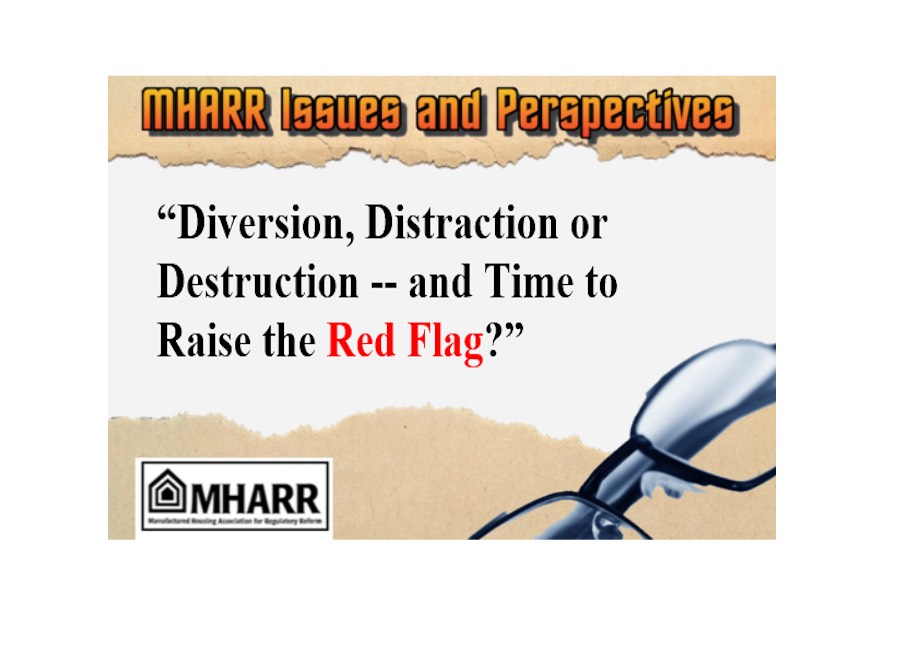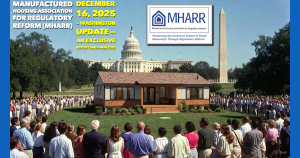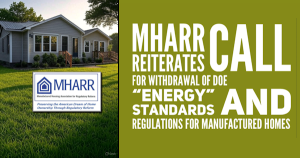[vc_row][vc_column][vc_column_text]According to recent press reports, nearly fifty percent (or more) of the HUD Code manufactured housing production market is currently held by one manufacturer, Clayton Homes, Inc. (Clayton), a wholly-owned subsidiary of Berkshire Hathaway Corporation (BHC). At the same time, at least thirty-five percent of the manufactured home consumer  finance market (as acknowledged by BHC in its 2016 Shareholder Letter) is controlled by Clayton financial affiliates Vanderbilt Mortgage Corporation (Vanderbilt) and 21st Mortgage Corporation (21st Mortgage). As of 2015, third-party studies further indicated that at least another twenty percent of the HUD Code production market was held by two other large corporate conglomerates, Cavco Industries, Inc. (Cavco) and Champion Homes, Inc. (Champion). All three of these production companies (i.e., Clayton, Cavco and Champion), moreover, are members of the same trade organization, the Manufactured Housing Institute (MHI), which publicly claims to represent companies responsible for “85 percent of [the HUD Code] manufactured homes produced each year.”
finance market (as acknowledged by BHC in its 2016 Shareholder Letter) is controlled by Clayton financial affiliates Vanderbilt Mortgage Corporation (Vanderbilt) and 21st Mortgage Corporation (21st Mortgage). As of 2015, third-party studies further indicated that at least another twenty percent of the HUD Code production market was held by two other large corporate conglomerates, Cavco Industries, Inc. (Cavco) and Champion Homes, Inc. (Champion). All three of these production companies (i.e., Clayton, Cavco and Champion), moreover, are members of the same trade organization, the Manufactured Housing Institute (MHI), which publicly claims to represent companies responsible for “85 percent of [the HUD Code] manufactured homes produced each year.”
Whether this particular statistic is entirely accurate or not is immaterial. What is material, is that the juggernaut created by this combination of the largest industry producers, is having two related – and simultaneously negative — impacts for the broader industry, for the smaller businesses that have constituted the traditional core of the industry, and for the moderate and lower-income homebuyers that the HUD Code industry has traditionally served.
On the one hand, this “consortium” of companies (among others), acting through MHI, has arguably failed, over the course of nearly two decades, to accomplish — or even seek — the full and proper implementation of the Manufactured Housing Improvement Act of 2000, with all of its intended benefits for manufactured housing and manufactured homebuyers but, instead, has taken actions and advocated positions that MHARR has had to block, oppose and/or fix (including, but not limited to: excessive energy regulation; unnecessary fire sprinkler standards, expanded in-plant regulation, and the selection of a career program administrator, rather than a non-career appointee, contrary to the law, to name just a few) in order to protect the industry and consumers. On the other, as is now becoming evident through their role in pursuing a so-called “new class” of manufactured homes, is an alarming trend toward activity that could further undermine free-market competition and concentrate yet more market power in the hands of the same few dominant companies.
Such combined activity by the largest three producers within the manufactured housing market (with Champion having now acquired significant additional market share through its reported merger with the Skyline Corporation) to, in MHI’s words, “help [MHI] members create” a new “class” of manufactured homes, and simultaneously “help with MHI’s legislative and regulatory efforts to change the existing HUD Code.” (See, February 8, 2017 MHI “Housing Alert”) (Emphasis added), involves decisions and actions that warrant careful analysis and consideration not only by the broader industry, but by relevant authorities as well. Indeed, while couched in generalities and vagaries over the past year, what this activity ultimately means to the industry as a whole, to the multitude of smaller industry businesses struggling to compete and survive in an over-regulated market increasingly dominated by a handful of large producers and their finance affiliates, and to the mostly lower and moderate-income Americans who rely on traditional manufactured housing as the nation’s primary source of inherently affordable, non-subsidized housing and home-ownership, could become a matter of economic life or death – i.e., a matter of the survival of the industry, its businesses and its products as they have existed for well-over a half-century, or their replacement by something far different.
Given the potentially far-reaching, industry and market-altering consequences of this secretive activity, it is both appropriate and necessary to ask: (1) what this “new class” of manufactured home initiative entails; (2) by whom is it being advanced and how; (3) why is it being advanced; (4) why is it being advanced now; and (5) who, ultimately, would benefit – or suffer — from its realization (or failure)? And, flowing from that analysis, is the proverbial sixty-four thousand-dollar question – i.e., what should smaller businesses within the industry and the American consumers who rely upon affordable, non-subsidized manufactured housing, as provided by the industry in its current and long-term traditional configuration, do (or seek to do) about all this?
These crucial questions — and their answers – do not exist in a vacuum. Instead, they arise against a specific backdrop and context of activity by and within the broader industry that is, itself, highly relevant. That context, in a nutshell, for a comprehensively federally-regulated industry – and notwithstanding the significant regulatory reform opportunities presented by the election of President Trump – is one of regulatory policies and actions (including the production and financing of HUD Code homes) that have devastated manufactured housing production levels (down 78 percent since 1998 despite a slow rebound from historic-low production levels in 2009), eliminated significant numbers of mostly smaller industry businesses, and have simultaneously allowed and driven an unhealthy consolidation within the industry’s production and post-production sectors that could ultimately be highly detrimental to both the industry and its consumers.
These actions and policies include, but are not limited to: (1) excessive, unnecessary and unreasonably-costly federal regulation (particularly over the last four years) by HUD that has disproportionately harmed smaller industry businesses while simultaneously benefiting the largest industry conglomerates; (2) pending efforts by other federal agencies to impose unnecessary, draconian and debilitating regulations on manufactured housing (including, but not limited to so-called “energy conservation” standards) that will also result in excessive, unreasonable and unnecessary regulatory compliance-cost increases; (3) an inadequately-competitive consumer financing market, dominated by the BHC-supported Clayton finance subsidiaries, as a consequence of the discriminatory failure of Fannie Mae and Freddie Mac to provide virtually any securitization or secondary market support for manufactured housing consumer loans; (4) glacial progress (if any) toward the legitimate (i.e., market-significant) implementation of the Duty to Serve Underserved Markets (DTS) mandate for the eighty-percent of the HUD Code market represented by chattel loans; and (5) the baseless, discriminatory local exclusion of manufactured homes from vast swaths of the country (particularly urban and suburban areas), among other things.
And, it is at the intersection of these demonstrable failures and the overriding self-interest of the industry-dominant corporate conglomerates, where the answers to the preceding questions can be found.
First, for all the secretiveness that has shrouded the details of this “new class of home” activity, its general contours and objectives – i.e., questions 1 and 2 above, what the “new class” of manufactured home activity is all about, who is advancing it and how — have been the subject of a great deal of pseudo-public talk and targeted disclosures. Thus, in a February 8, 2017 “Housing Alert,” MHI states that the initiative’s “goal is to obtain information on [the] wants, needs, preferences and perceptions [of various underserved homebuyers] and then develop a strategy to help members create an offering that meets the housing needs of these groups … and help with MHI’s legislative and regulatory efforts to change the existing HUD Code. For this research initiative, MHI is working with a diverse group of its manufacturer members and Ducker Worldwide, a respected independent consultant with extensive experience in the residential housing industry, including both site-built and manufactured housing” (Emphasis added). The same “Housing Alert” identifies members of the “Task Force” responsible for the “new class of home” initiative, with the President and CEO of Clayton Homes, Inc., the Chairman and CEO of Cavco Industries, Inc., the President of Champion Home Builders, the President and CEO of Skyline Corporation (now reportedly merging with Champion) and the President of MHI, constituting five of the seven named members, and the “Managing Principal of Ducker Worldwide” identified as the sixth member of the “Task Force.”
From this MHI description, certain key facts emerge: (1) the initiative and potential development of a “new class” of manufactured homes is restricted to MHI “members;” (2) the initiative and potential development of a “new class” of manufactured homes is directed and controlled by a sub-group of MHI members that, in turn, is dominated by the industry’s largest manufacturers; (3) the initiative “Task Force,” or, more accurately, “control group,” includes no small businesses or small business representatives; (4) the initiative control group includes no representative(s) of a business or businesses engaged solely or specifically in the industry’s post-production sector; and (5) the initiative control group includes no state association representatives — among other things. The “new class” of homes “initiative,” therefore, is a cooperative project of a market-dominant group of ostensible “competitors,” apparently seeking coordinated market advantage – and expanded market dominance.
In addition, the “new class” of homes initiative is expressly tied by MHI to efforts to “change” the existing federal standards governing the construction, safety and installation of manufactured homes in unspecified and unstated ways, presumably to accommodate (or otherwise facilitate) unnamed aspects of the “new class” of home and those who produce (and are otherwise connected with sales of) that “new class” of homes. Thus, development of the “new class” of manufactured home by a restricted group of the industry’s three largest producers is targeted to drive corresponding government relations advocacy seeking changes to existing legal requirements (or, potentially new legal criteria) relating to those homes and their sale. This “new class” of homes, in turn, would have the likely effect of relegating traditional manufactured homes back to the status of “trailers,” thereby effectively undermining the work done by MHARR and others over the course of decades to achieve statutory and policy parity between traditional manufactured homes and all other types of residential construction, with corresponding negative impacts for producers and retailers of those homes and current owners/purchasers of those homes in the form of potentially reduced value and suppressed appreciation.
Nor is this apparent effort to “grease the skids” and elevate the status of a “new class” of manufactured homes – controlled by the industry’s market-dominant producers — necessarily restricted to production standards and regulations.
Sales and production of traditional manufactured homes have been unnecessarily restricted (for decades) due, in part, to the unavailability of secondary market and securitization support for manufactured housing consumer loans by the Government Sponsored Enterprises (GSEs), Fannie Mae and Freddie Mac. This lack of support has prevented full and robust competition within the manufactured housing market, has allowed the existing market-dominant companies to maintain higher-cost interest rates through their captive finance affiliates, and has limited the availability of consumer financing for potential purchasers of manufactured homes. Congress sought to remedy this ongoing failure through the Duty to Serve Underserved Markets provision of the Housing and Economic Reform Act of 2008 (HERA), but the GSEs have consistently resisted — and continue, at a minimum, to resist and delay — the market-significant implementation of DTS, particularly with respect to manufactured housing chattel loans. Thus, it is relevant that in July 2017 — prior to FHFA approval of the Fannie Mae and Freddie Mac DTS “final” so-called “implementation” plans — the aforementioned “Managing Principal of Ducker Worldwide” leading the “new class of homes” research initiative and serving as a member of the “new class of homes” control group, led (according to a Ducker Worldwide publication) “a seminar for various leaders of Fannie Mae and Freddie Mac” coincidentally addressing the same topics as his “research” work for MHI (which dates back to at least February 2014).
Whether this contact with FHFA and the GSEs was isolated or is part of a broader pattern is not known. Nor is it clear what potential impact this contact (or possibly others) might have had on the “final” GSE DTS “implementation” plans or their approval by FHFA, which — some 10-13 years-out from the enactment of DTS — would serve, at a maximum, a paltry 1.85% of the manufactured housing chattel loan market.
But given the lack of market-significant implementation of DTS in the now-FHFA-approved “final” DTS implementation plans, and other aspects of both plans that would empower the largest industry conglomerates and their respective affiliates and surrogates to influence the alleged “implementation” of DTS, detailed in a recent (January 5, 2018) MHARR News Release – including, but not limited to: (1) an announcement that Fannie Mae will become a (presumably dues-paying) “member of the Manufactured Housing Institute,” (presumably utilizing funds subject to FHFA/federal government conservatorship); (2) an announcement by Fannie Mae that it will create a “manufactured housing advisory council” that will include “one industry trade association” and multiple other members, but only one “smaller” manufacturer; (3) an announcement by Freddie Mac that it will “partner” with “Next Step Network, Inc.,” a beneficiary of extensive grants from Clayton and MHI to, among other things, conduct a “working group,” the “Smart MH Task Force,” to “provide market intelligence and data to inform loan product needs,” without ensuring either a balance of interests or the inclusion of small businesses or small business representatives within that “working group;” and (4) creation of a new “MH Select” program (developed through the involvement of a former MHI Vice President) for certain “quality manufactured homes” based on criteria that exceed certain HUD standards (including “back door” energy criteria promoted by an MHI affiliate, the “Systems Building Research Alliance”) – one is left to wonder what impact the Ducker Worldwide (and possibly other contacts with the GSEs and FHFA) might have had, given the market-based reality that every day which goes by without the market-significant implementation of DTS, is a massive economic gift to Clayton, the Clayton finance affiliates, BHC and their respective beneficiaries.
As to questions 3, 4 and 5, above – i.e., why this “new class of homes” initiative is being advanced; why it’s being advanced now; and who, ultimately, will benefit from its realization, the answers should be mostly apparent. Quite simply, it would appear that this “initiative” it is being advanced — primarily – to benefit the industry’s largest conglomerates by allowing those conglomerates to: (1) maximize and expand their existing market advantages and domination; and (2) further weaken and undermine remaining competitors by effectively positioning traditional manufactured homes as a “second-class” product in terms of both regulation, financing terms and financing availability.
Moreover, it appears that this effort is being advanced now because the industry stands at a political/historical crossroads with the election of a transparently anti-regulation, pro-jobs, pro-small business and pro-affordable homeownership Administration in Washington, D.C. The manufactured housing industry, as MHARR has stressed continually, is the beneficiary of two outstanding federal laws, the 1974 manufactured housing law, as amended by the Manufactured Housing Improvement Act of 2000 and the “Duty to Serve.” These laws, as written and enacted, should provide manufactured housing and the manufactured housing industry with significant market advantages, sufficient to support annual production levels in the hundreds-of-thousands-of homes, if they were fully and properly implemented. The fact that they have not been implemented in that manner, has been the constant focus of MHARR – and the target of most of its legislative and administrative activity — for years. But now, just when it appears that an administration is in place which may finally be committed to fundamentally change the leadership, composition and nature of the HUD manufactured housing program in ways that could open the floodgates for new production, new producers and increased competition, based on reduced regulatory burdens and greater affordability for millions of Americans, the industry-dominant conglomerates within MHI seem to be shifting the focus of that organization in ways that would help to preserve and expand the conglomerates’ market-dominance to the detriment of others.
None of the secretiveness that has surrounded the “new class” of homes activity is necessary to achieve any legitimate purpose. New types of manufactured home designs with new features or amenities are not, in any way, objectionable. The manufactured housing industry should – and must – evolve in order to grow and expand. New features, new designs and new models, even if they exceed current federal standards, are not problematic in and of themselves. The HUD Code, as established by federal law, is a base standard that can always by exceeded. And, if need be, new ideas can be brought to the Manufactured Housing Consensus Committee (MHCC) for proposed changes to the standards and regulations if they achieve consensus support. But there is a legitimate, open, public process to achieve all this, which does not involve or require secretiveness, restrictions on involvement or participation, or coordination and de facto control by the industry’s largest conglomerates. Nor does it require changes to a law that itself is flexible and adaptable enough to meet the changing needs of consumers and the industry — when it is entrusted to the proper hands.
The issue, therefore, is ultimately one of intent and purpose. New products are fine. But a secretive program to change the essence of manufactured housing, that would effectively relegate the industry’s existing product(s) to some sort of “second-class” status – with corresponding changes to the industry’s governing law – for the purpose of securing even greater competitive advantages for already market-dominant industry businesses, is not fine and, in fact, must be resisted by the broader industry and consumers as well.
Mark Weiss
MHARR is a Washington, D.C.-based national trade association representing the views and interests of independent producers of federally-regulated manufactured housing.
“MHARR-Issues and Perspectives” is available for re-publication in full (i.e., without alteration or substantive modification) without further permission and with proper attribution to MHARR. [/vc_column_text][/vc_column][/vc_row]













